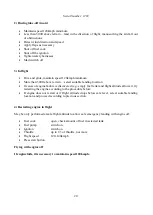
Serial Number: 1203
13
Caution!
Neither of the engines mentioned above is certified as an aircraft engine. Even with
utmost attention during engine manufacture, engine failure may occur at any time
during flight and the pilot bears full responsibility for the consequences. According to
UL1 regulation, the pilot must always select bearing and altitude allowing him/her to
glide down and land safely at suitable location.
C) Propeller
Fixed-pitch PESZKE propeller as well as VARIA 170/2R adjustable-pitch propeller may be used.
For the description of the propeller delivered with your aircraft, see the instructions for the propeller
installation and maintenance, delivered along with the aircraft.
D) Equipment
The aircraft may be equipped with traditional analogue instruments, together with GPS navigation
or a glass cockpit incorporating flight, engine and navigation instruments, including a transponder.
2.6
Controls
Pedals – pressing left pedal turns aircraft left both on the ground and in the air, and vice versa.
Hand controls – pulling the yoke backwards, towards the pilot, raises the nose of aircraft (the angle
of attack increases) and the aircraft climbs. Pushing the yoke forward dives the aircraft. Turning the
yoke to the left banks the aircraft to the left, and vice versa.
Engine throttle – moving combined controller located on the middle-panel forward from its central
position, in the flight direction, increases engine output, and vice versa.
Brake control – pulling combined controller backwards, in the opposite direction of taxiing, brakes
the aircraft. Moving the controller backwards and pressing the detent locks the brake (parking
brake). To release the parking brake, pull brake lever or combined controller backwards.
2.7
Engineering data
(a) Dimensions
Wing span
9.1m
Length
7.05m
Height, total
2.6m
Wing surface
10.84m
2
Wing aspect ratio
7.64
Depth of MAC (mean aerodynamic chord)
1200mm
Wing profile
MS 313 B
At root
1300mm
At tip
880 mm
Wing flaps surface
1.75m
2





































